Building Energy Consumption Prediction: An Extreme Deep Learning Approach
Abstract
:1. Introduction
2. Methodology
2.1. The Stacked Autoencoder
2.1.1. Autoencoder
2.1.2. Sparse Autoencoder
2.1.3. The Structure of the Stacked Autoencoder
2.2. Extreme Stacked Autoencoder and Its Training Algorithm
2.2.1. Pre-Training of the Stacked Autoencoder Part
- Step 1: Train the first layer as an autoencoder by minimizing Equation (3) using the training samples as the input, and let .
- Step 2: Train the vth layer by minimizing Equation (3) using as its input.
- Step 3: Let , and iterate Step 2 until .
- Step 4: Output and use it as the input of the predictor.
2.2.2. Least-Squares Learning of the Extreme Learning Machine Part
3. Energy Consumption Prediction Model
3.1. Applied Data Set
3.2. Energy Consumption Prediction Model
3.3. Experimental Setting
4. Experiments
4.1. Thirty Minute Prediction of Building Energy Consumption
4.1.1. Determination of the Optimal Input Variables
4.1.2. Configuration of the Prediction Models
4.1.3. Results
4.2. Sixty Minute Prediction of Building Energy Consumption
4.2.1. Determination of the Optimal Input Variables
4.2.2. Configuration of the Prediction Models
4.2.3. Results
4.3. Comparisons and Discussion
5. Conclusions
Acknowledgments
Author Contributions
Conflicts of Interest
References
- Štreimikienė, S. Residential energy consumption trends, main drivers and policies in Lithuania. Renew. Sustain. Energy Rev. 2014, 35, 285–293. [Google Scholar] [CrossRef]
- Ugursal, V.I. Energy consumption, associated questions and some answers. Appl. Energy 2014, 130, 783–792. [Google Scholar] [CrossRef]
- Hua, C.; Lee, W.L.; Wang, X. Energy assessment of office buildings in China using China building energy codes and LEED 2.2. Energy Build. 2015, 86, 514–524. [Google Scholar]
- Zuo, J.; Zhao, Z.Y. Green building research-current status and future agenda: A review. Renew. Sustain. Energy Rev. 2014, 30, 271–281. [Google Scholar] [CrossRef]
- Daut, M.A.M.; Hassan, M.Y.; Abdullah, H.; Rahman, H.A.; Abdullah, M.P.; Hussin, F. Building electrical energy consumption forecasting analysis using conventional and artificial intelligence methods: A review. Renew. Sustain. Energy Rev. 2017, 70, 1108–1118. [Google Scholar] [CrossRef]
- Li, K.; Hu, C.; Liu, G.; Xue, W. Building’s electricity consumption prediction using optimized artificial neural networks and principal component analysis. Energy Build. 2015, 108, 106–113. [Google Scholar] [CrossRef]
- Pombeiro, H.; Santos, R.; Carreira, P.; Silva, C.; Sousa, J.M.C. Comparative assessment of low-complexity models to predict electricity consumption in an institutional building: Linear regression vs. fuzzy modeling vs. neural networks. Energy Build. 2017, 146, 141–151. [Google Scholar] [CrossRef]
- Jimenez, M.J.; Heras, M.R. Application of multi-output ARX models for estimation of the U and g values of building components in outdoor testing. Sol. Energy 2005, 79, 302–310. [Google Scholar] [CrossRef]
- Kimbara, A.; Kurosu, S.; Endo, R.; Kamimura, K.; Matsuba, T.; Yamada, A. On-line prediction for load profile of an air-conditioning system. Ashrae Trans. 1995, 101, 198–207. [Google Scholar]
- Newsham, G.R.; Birt, B.J. Building-level occupancy data to improve ARIMA-based electricity use forecasts. In Proceedings of the 2nd ACM Workshop on Embedded Sensing Systems for Energy-Efficiency in Building, Zurich, Switzerland, 2 November 2010; pp. 13–18. [Google Scholar]
- Aydinalp-Koksal, M.; Ugursal, V.I. Comparison of neural network, conditional demand analysis, and engineering approaches for modeling end-use energy consumption in the residential sector. Appl. Energy 2008, 85, 271–296. [Google Scholar] [CrossRef]
- Hsu, D. Comparison of integrated clustering methods for accurate and stable prediction of building energy consumption data. Appl. Energy 2015, 160, 153–163. [Google Scholar] [CrossRef]
- Alvarez, F.M.; Troncoso, A.; Riquelme, J.C.; Ruiz, J.S.A. Energy time series forecasting based on pattern sequence similarity. IEEE Trans. Knowl. Data Eng. 2011, 23, 1230–1243. [Google Scholar] [CrossRef]
- Pérez-Chacón, R.; Talavera-Llames, R.L.; Martinez-Alvarez, F.; Troncoso, A. Finding electric energy consumption patterns in big time series data. In Proceedings of the13th International Conference Distributed Computing and Artificial Intelligence, Sevilla, Spain, 1–3 June 2016; Springer: Cham, Switzerland, 2016; pp. 231–238. [Google Scholar]
- Martínez-Álvarez, F.; Troncoso, A.; Asencio-Cortés, G.; Riquelme, J.C. A survey on data mining techniques applied to electricity-related time series forecasting. Energies 2015, 8, 13162–13193. [Google Scholar] [CrossRef]
- Tso, G.K.F.; Yau, K.K.W. Predicting electricity energy consumption: A comparison of regression analysis, decision tree and neural networks. Energy 2007, 32, 1761–1768. [Google Scholar] [CrossRef]
- Ahmad, M.W.; Mourshed, M.; Rezgui, Y. Trees vs. Neurons: Comparison between random forest and ANN for high-resolution prediction of building energy consumption. Energy Build. 2017, 147, 77–89. [Google Scholar] [CrossRef]
- Paudel, S.; Elmitri, M.; Couturier, S.; Nguyen, P.H.; Kamphuis, R.; Lacarrière, B.; Corre, O.L. A relevant data selection method for energy consumption prediction of low energy building based on support vector machine. Energy Build. 2017, 138, 240–256. [Google Scholar] [CrossRef]
- Mena, R.; Rodríguez, F.; Castilla, M.; Arahal, M.R. A prediction model based on neural networks for the energy consumption of a bioclimatic building. Energy Build. 2014, 82, 142–155. [Google Scholar] [CrossRef]
- Biswas, M.A.R.; Robinson, M.D.; Fumo, N. Prediction of residential building energy consumption: A neural network approach. Energy 2016, 117, 84–92. [Google Scholar] [CrossRef]
- Naji, S.; Shamshirband, S.; Basser, H.; Keivani, A.; Alengaram, U.J.; Jumaat, M.Z.; Petkovic, D. Application of adaptive neuro-fuzzy methodology for estimating building energy consumption. Renew. Sustain. Energy Rev. 2016, 53, 1520–1528. [Google Scholar] [CrossRef]
- Ekici, B.B.; Aksoy, U.T. Prediction of building energy needs in early stage of design by using ANFIS. Expert Syst. Appl. 2011, 38, 5352–5358. [Google Scholar] [CrossRef]
- Yang, J.; Rivard, H.; Zmeureanu, R. On-line building energy prediction using adaptive artificial neural networks. Energy Build. 2005, 37, 1250–1259. [Google Scholar] [CrossRef]
- Naji, S.; Keivani, A.; Shamshirband, S.; Alengaram, U.J.; Jumaat, M.Z.; Mansor, Z.; Lee, M. Estimating building energy consumption using extreme learning machine method. Energy 2016, 97, 506–516. [Google Scholar] [CrossRef]
- Zhang, Y.; Chen, Q. Prediction of building energy consumption based on PSO-RBF neural network. In Proceedings of the IEEE International Conference on System Science and Engineering, Shanghai, China, 11–13 July 2014; pp. 60–63. [Google Scholar]
- Hinton, G.E.; Osindero, S.; Teh, Y.W. A fast learning algorithm for deep belief nets. Neural Comput. 2014, 18, 1527–1554. [Google Scholar] [CrossRef] [PubMed]
- Collobert, R.; Weston, J. A unified architecture for natural language processing: Deep neural networks with multitask learning. In Proceedings of the 25th International Conference on Machine Learning, Helsinki, Finland, 5–9 July 2008; pp. 160–167. [Google Scholar]
- Hinton, G.E.; Salakhutdinov, R.R. Reducing the dimensionality of data with neural networks. Science 2006, 313, 504–507. [Google Scholar] [CrossRef] [PubMed]
- Huval, B.; Coates, A.; Ng, A. Deep learning for class-generic object detection. arXiv, 2013; arXiv:1312.6885. [Google Scholar]
- Qiu, X.; Zhang, L.; Ren, Y.; Suganthan, P.N.; Amaratunga, G. Ensemble deep learning for regression and time series forecasting. In Proceedings of the 2014 IEEE Symposium on Computational Intelligence in Ensemble Learning (CIEL), Orlando, FL, USA, 9–12 December 2014; pp. 1–6. [Google Scholar]
- Li, L.; Lv, Y.; Wang, F.Y. Traffic signal timing via deep reinforcement learning. IEEE/CAA J. Autom. Sin. 2016, 3, 247–254. [Google Scholar]
- Lv, Y.; Duan, Y.; Kang, W.; Li, Z.; Wang, F.Y. Traffic flow prediction with big data: A deep learning approach. IEEE Trans. Intell. Transp. Syst. 2015, 16, 865–873. [Google Scholar] [CrossRef]
- Torres, J.; Fernández, A.; Troncoso, A.; Martínez-Álvarez, F. Deep learning-based approach for time series forecasting with application to electricity load. In Proceedings of the International Work-Conference on the Interplay between Natural and Artificial Computation, Corunna, Spain, 19–23 June2017; Springer: Cham, Switzerland, 2017; pp. 203–212. [Google Scholar]
- Bengio, Y.; Lamblin, P.; Dan, P.; Larochelle, H. Greedy layer-wise training of deep networks. In Proceedings of the International Conference on Neural Information Processing Systems, Vancouver, BC, Canada, 4–7 December 2006; pp. 153–160. [Google Scholar]
- Vincent, P.; Larochelle, H.; Bengio, Y.; Manzagol, P.A. Extracting and composing robust features with denoising autoencoders. In Proceedings of the 25th International Conference on Machine Learning, Helsinki, Finland, 5–9 July 2008; ACM: New York, NY, USA, 2008; pp. 1096–1103. [Google Scholar]
- Palm, R.B. Prediction as a Candidate for Learning Deep Hierarchical Models of Data; Technical University of Denmark: Kongens Lyngby, Denmark, 2012; Volume 5. [Google Scholar]
- Hosseiniasl, E.; Zurada, J.M.; Nasraoui, O. Deep learning of part-based representation of data using sparse autoencoders with nonnegativity constraints. IEEE Trans. Neural Netw. Learn. Syst. 2016, 27, 2486–2498. [Google Scholar] [CrossRef] [PubMed]
- Xu, J.; Xiang, L.; Liu, Q.; Gilmore, H.; Wu, J.; Tang, J.; Madabhushi, A. Stacked sparse autoencoder (SSAE) for nuclei detection on breast cancer histopathology images. IEEE Trans. Med. Imaging 2016, 35, 119–130. [Google Scholar] [CrossRef] [PubMed]
- Tao, C.; Pan, H.; Li, Y.; Zou, Z. Unsupervised spectral-spatial feature learning with stacked sparse autoencoder for hyperspectral imagery classification. IEEE Geosci. Remote Sens. Lett. 2015, 12, 2438–2442. [Google Scholar]
- Erhan, D.; Bengio, Y.; Courville, A.; Manzagol, P.A.; Vincent, P.; Bengio, S. Why does unsupervised pre-training help deep learning? J. Mach. Learn. Res. 2010, 11, 625–660. [Google Scholar]
- Huang, G.B.; Wang, D.H.; Lan, Y. Extreme learning machines: A survey. Int. J. Mach. Learn. Cybern. 2011, 2, 107–122. [Google Scholar] [CrossRef]
- Huang, G.B.; Zhu, Q.Y.; Siew, C.K. Extreme learning machine: Theory and applications. Neurocomputing 2006, 70, 489–501. [Google Scholar] [CrossRef]
- Li, M.B.; Huang, G.B.; Saratchandran, P.; Sundararajan, N. Letters: Fully complex extreme learning machine. Neurocomputing 2005, 68, 306–314. [Google Scholar] [CrossRef]
- Erb, R.J. Introduction to backpropagation neural network computation. Pharm. Res. 1993, 10, 165–170. [Google Scholar] [CrossRef] [PubMed]
- Awad, M.; Khanna, R. Support vector regression. Neural Inf. Process. Lett. Rev. 2007, 11, 203–224. [Google Scholar]
- Friedrichs, F.; Schmitt, M. On the power of Boolean computations in generalized RBF neural networks. Neurocomputing 2005, 63, 483–498. [Google Scholar] [CrossRef]
- Preacher, K.J.; Curran, P.J.; Bauer, D.J. Computational tools for probing interactions in multiple linear regression, multilevel modeling, and latent curve analysis. J. Educ. Behav. Stat. 2006, 31, 437–448. [Google Scholar] [CrossRef]
- Eberly, L.E. Multiple linear regression. Methods Mol. Biol. 2007, 404, 165–187. [Google Scholar] [PubMed]
- Chong, T.L. Estimating the differencing parameter via the partial autocorrelation function. J. Econom. 1998, 97, 365–381. [Google Scholar] [CrossRef]
- Zhang, Z.; Law, C.L.; Gunawan, E. Multipath mitigation technique based on partial autocorrelation function. Wirel. Pers. Commun. 2007, 41, 145–154. [Google Scholar] [CrossRef]
- Alder, B.J.; Wainwright, T.E. Decay of the Velocity Autocorrelation Function. Phys. Rev. A 1970, 1, 18–21. [Google Scholar] [CrossRef]
- Jiang, X.; Adeli, H. Wavelet Packet-Autocorrelation Function Method for Traffic Flow Pattern Analysis. Comput. Aided Civ. Infrastruct. Eng. 2010, 19, 324–337. [Google Scholar] [CrossRef]
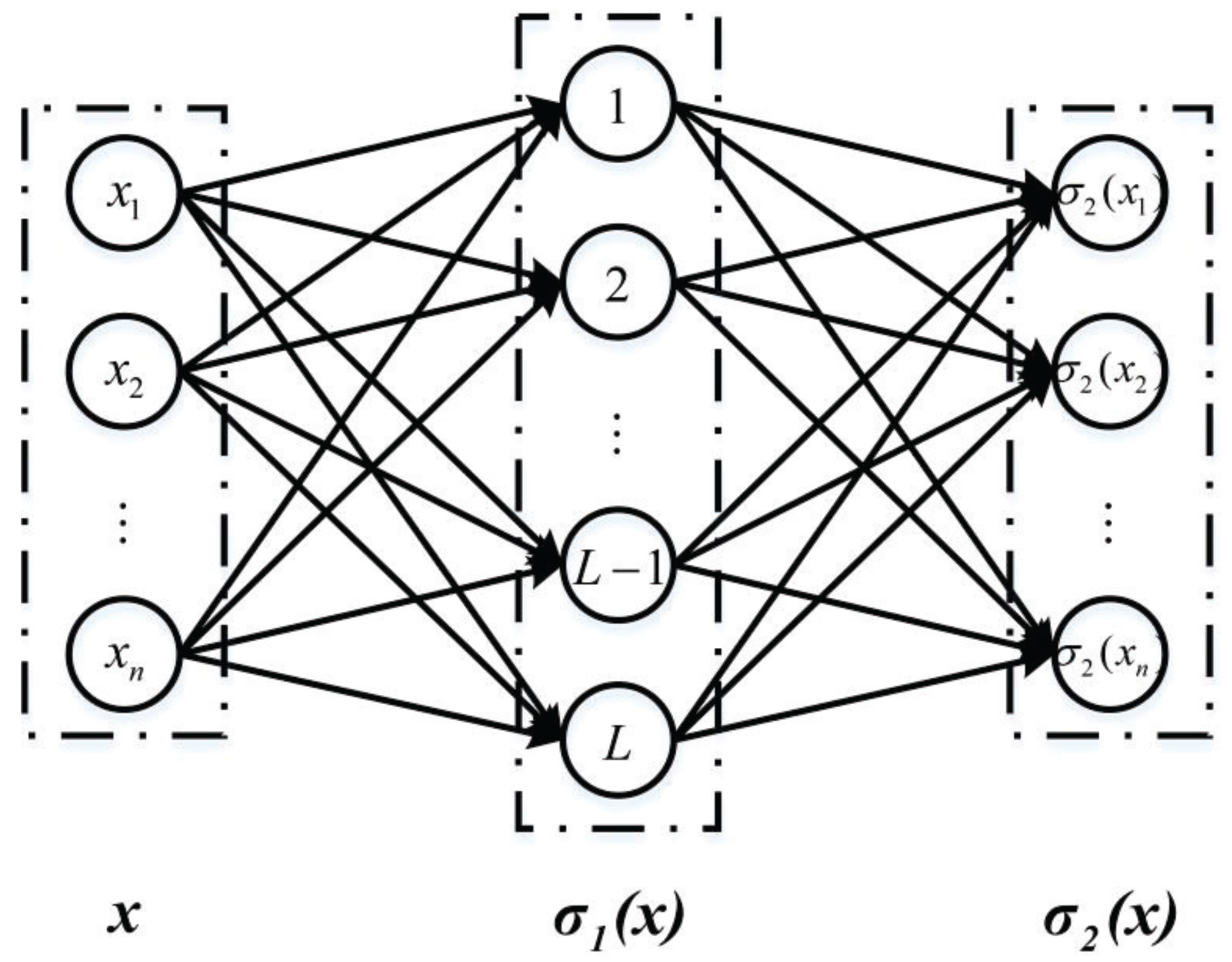
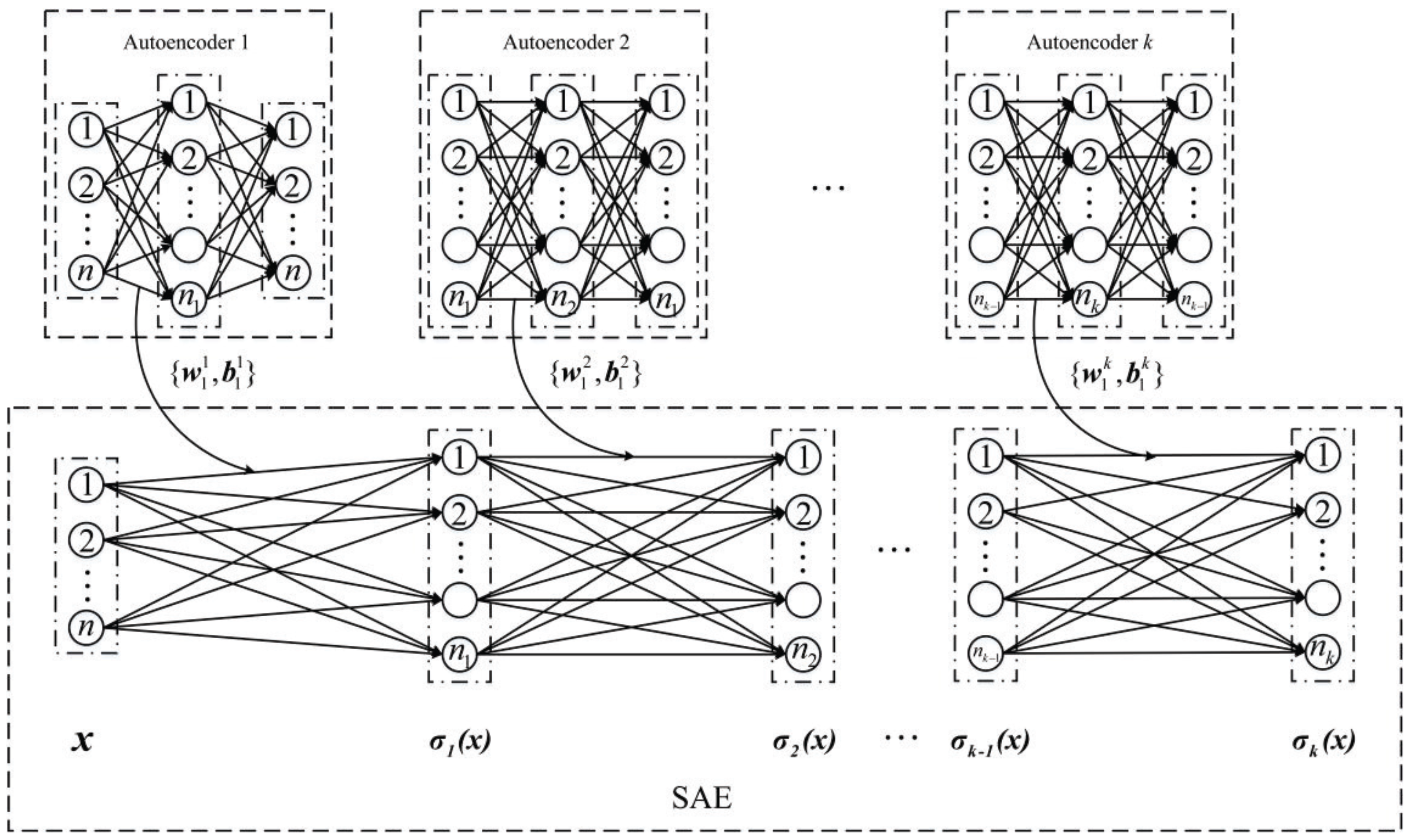
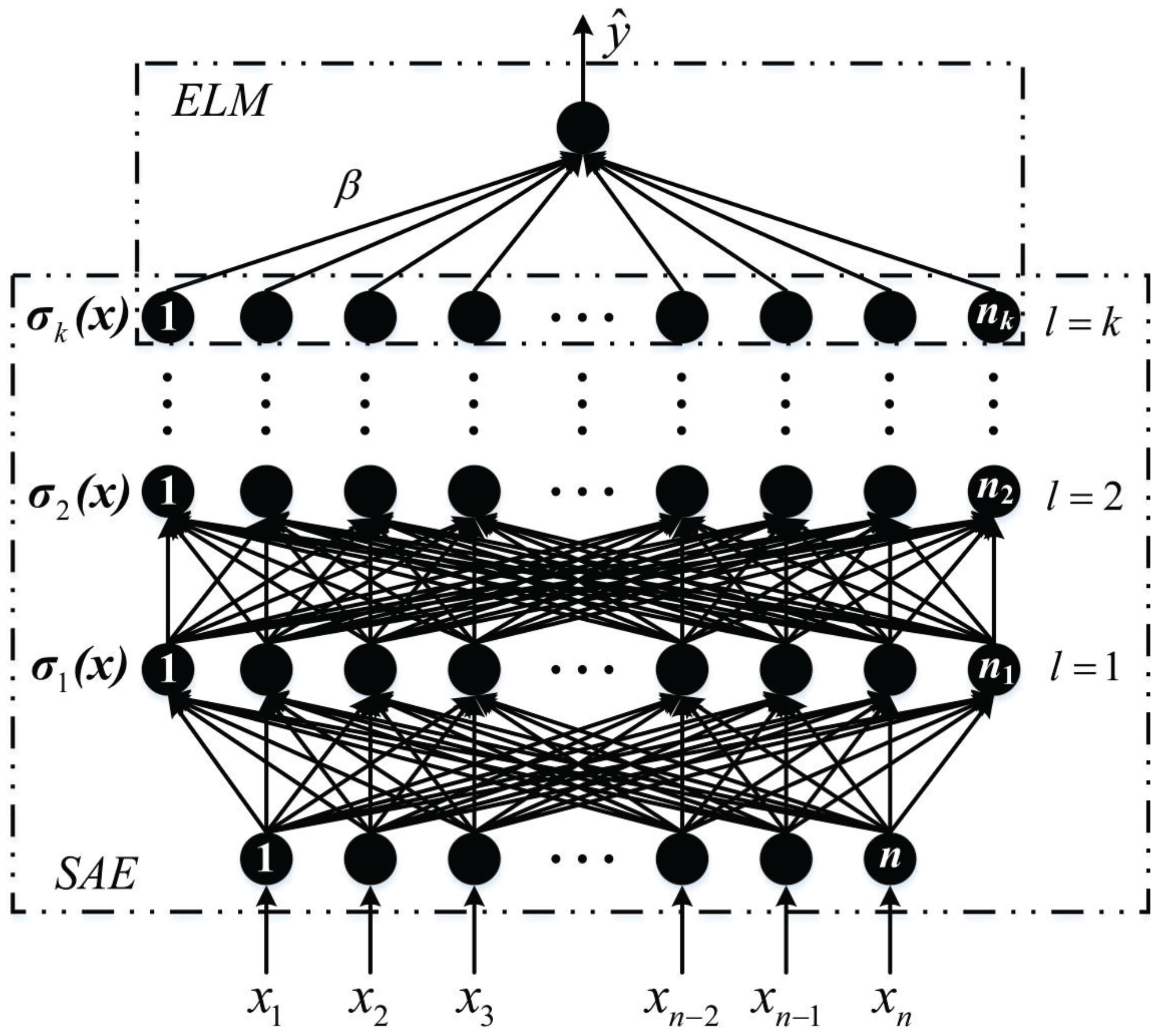

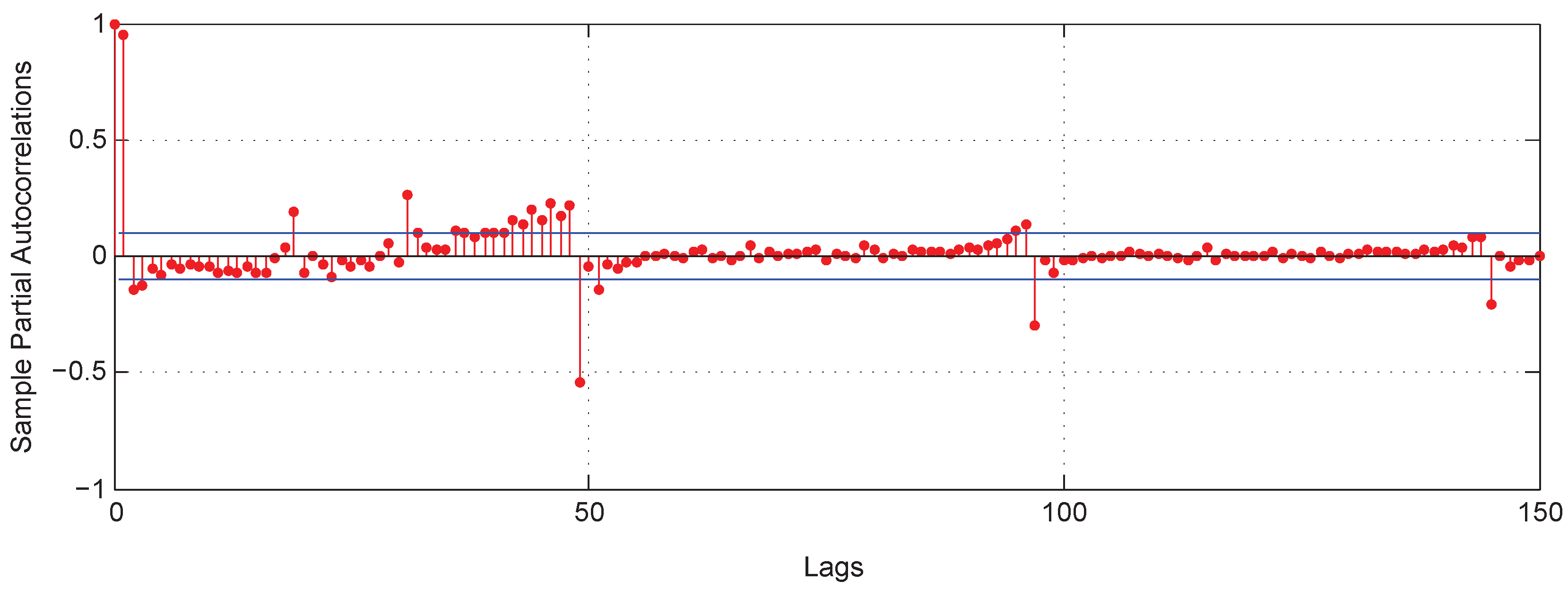
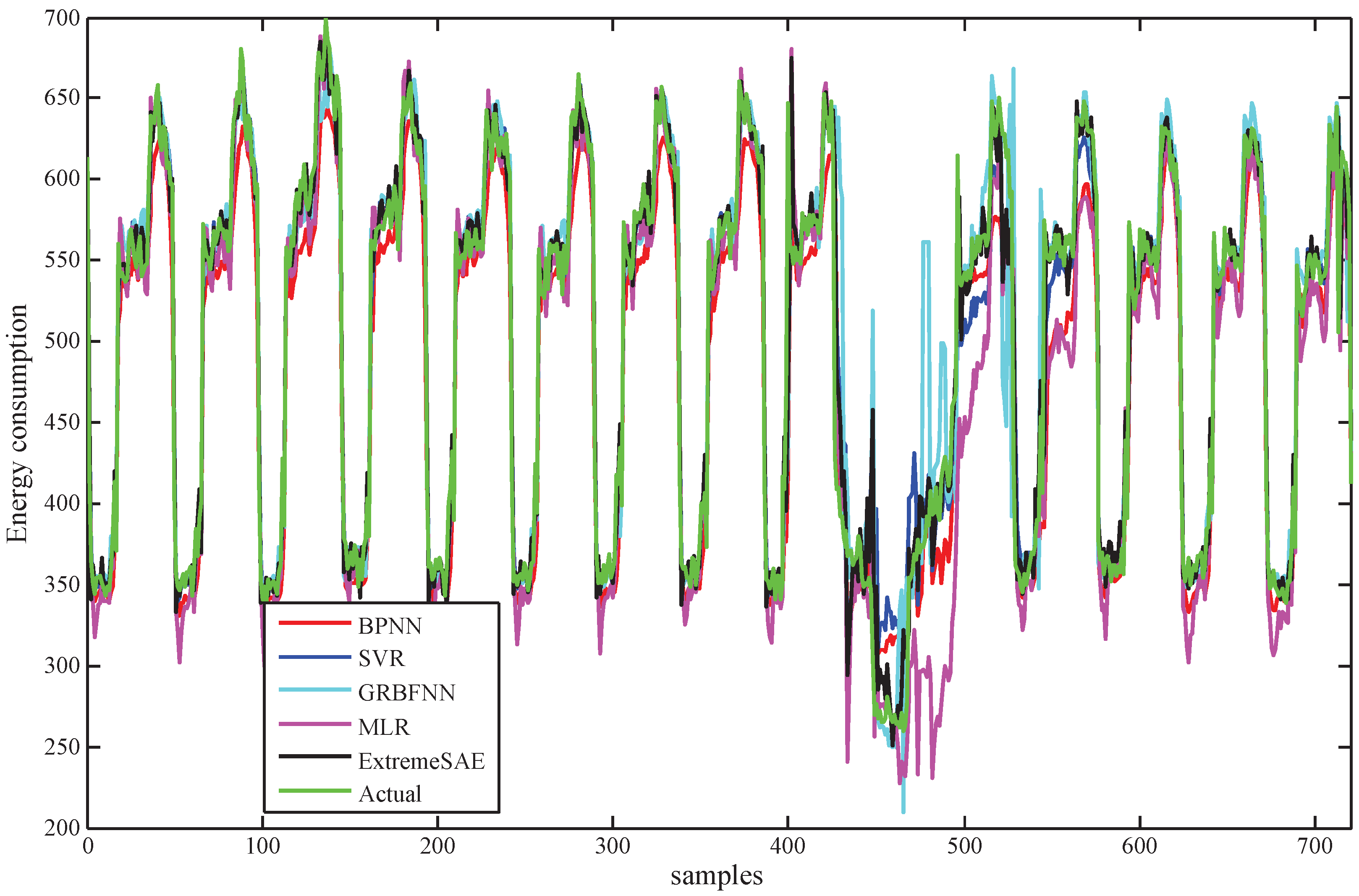
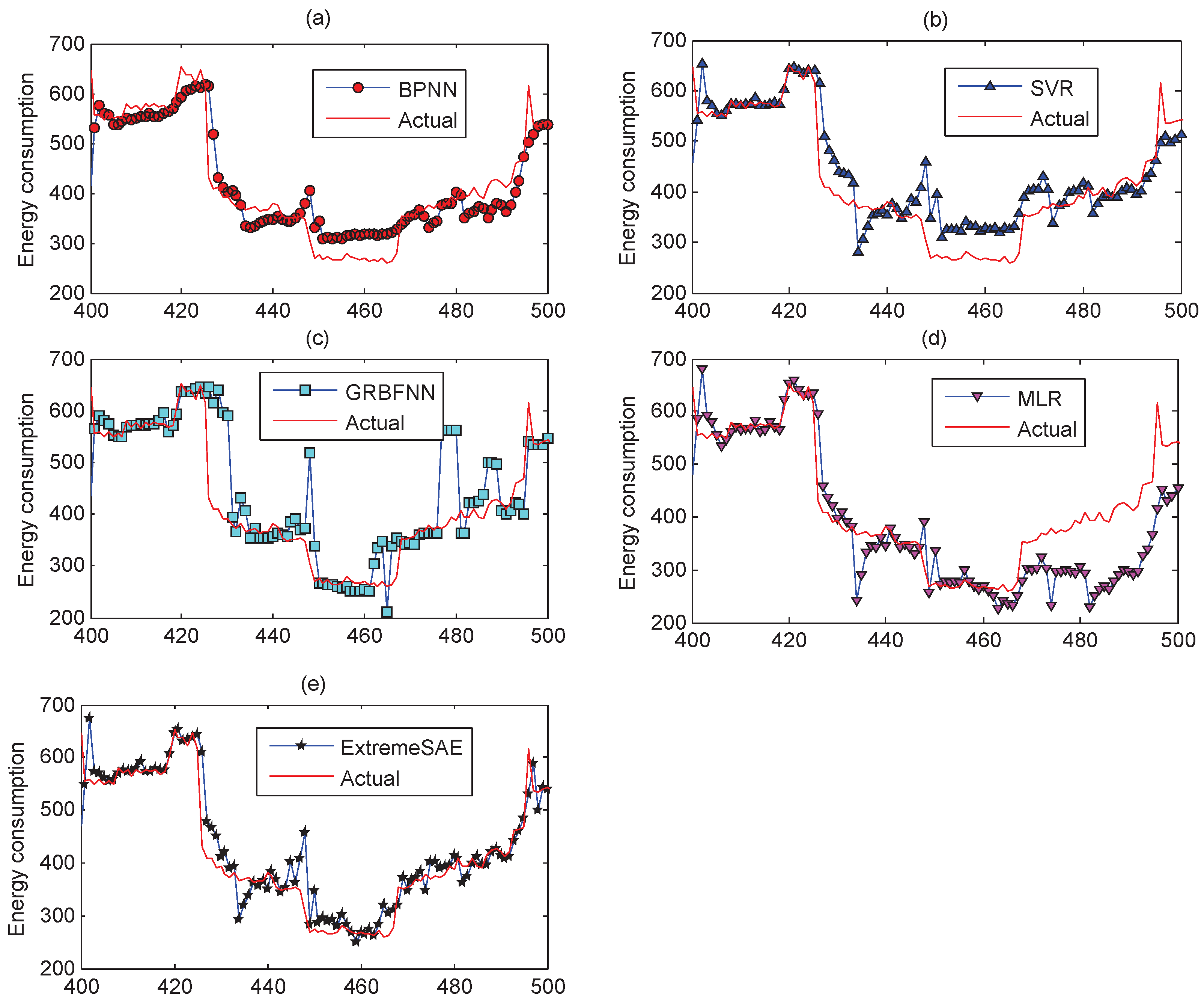
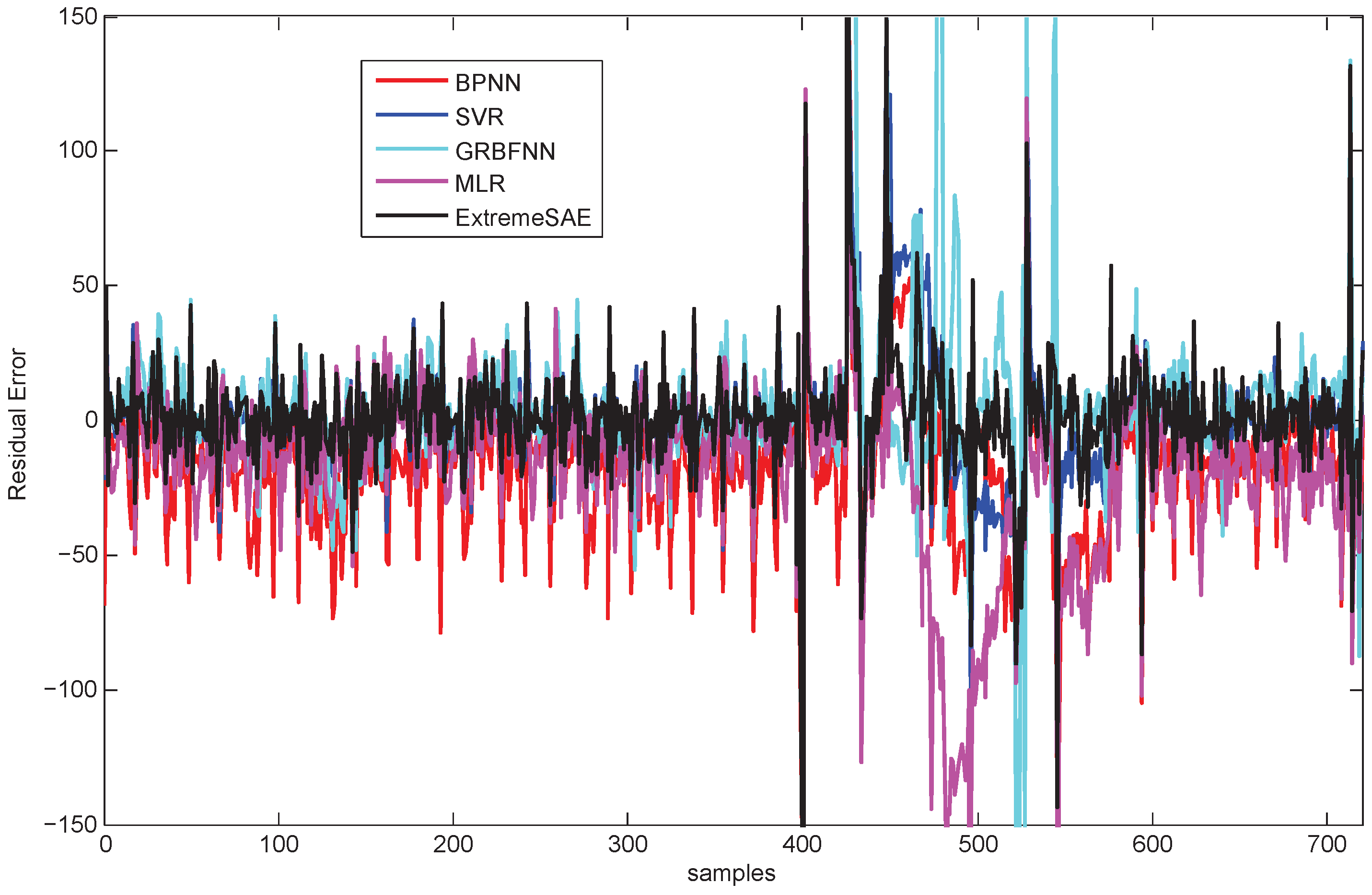
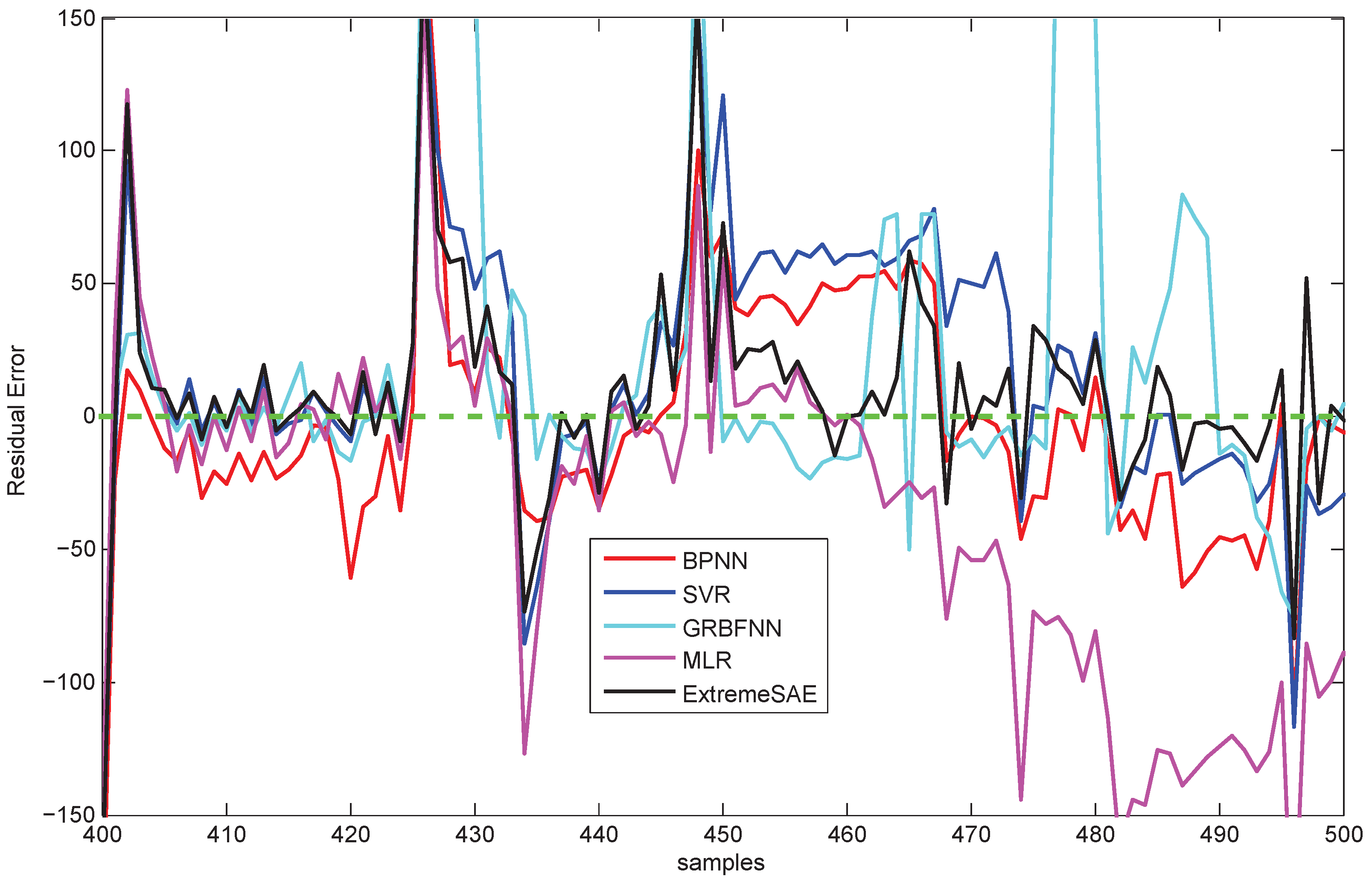
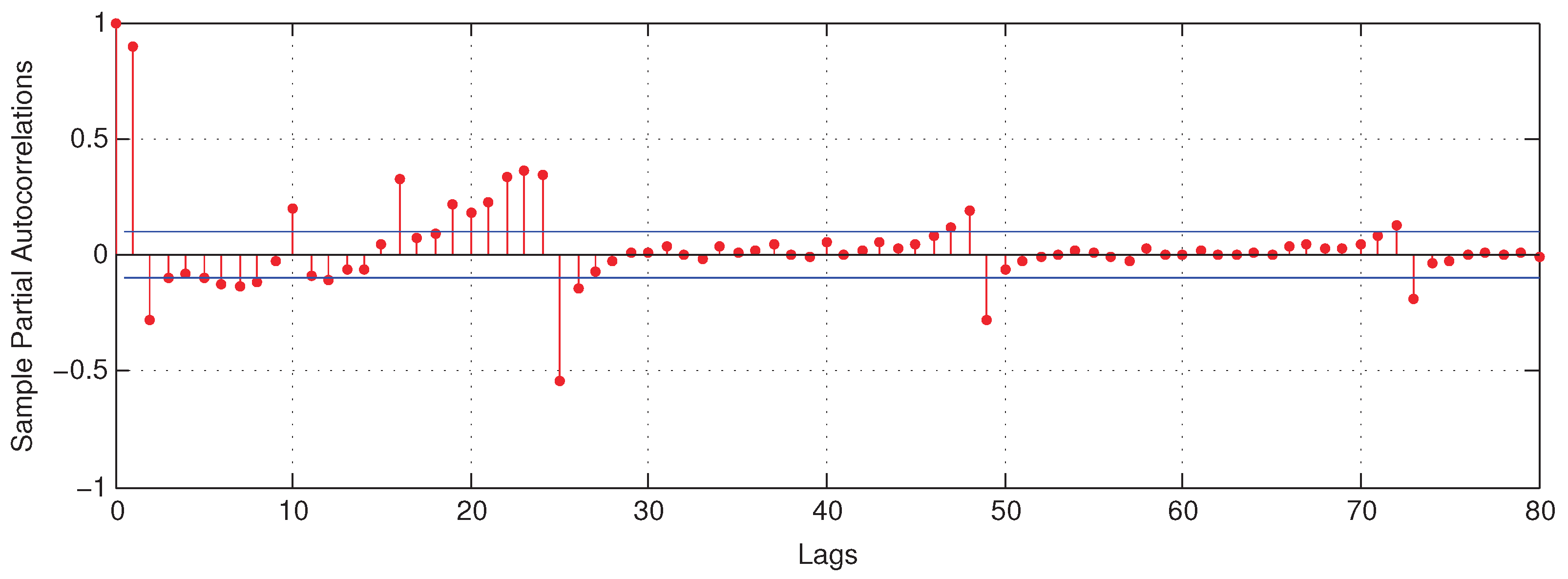



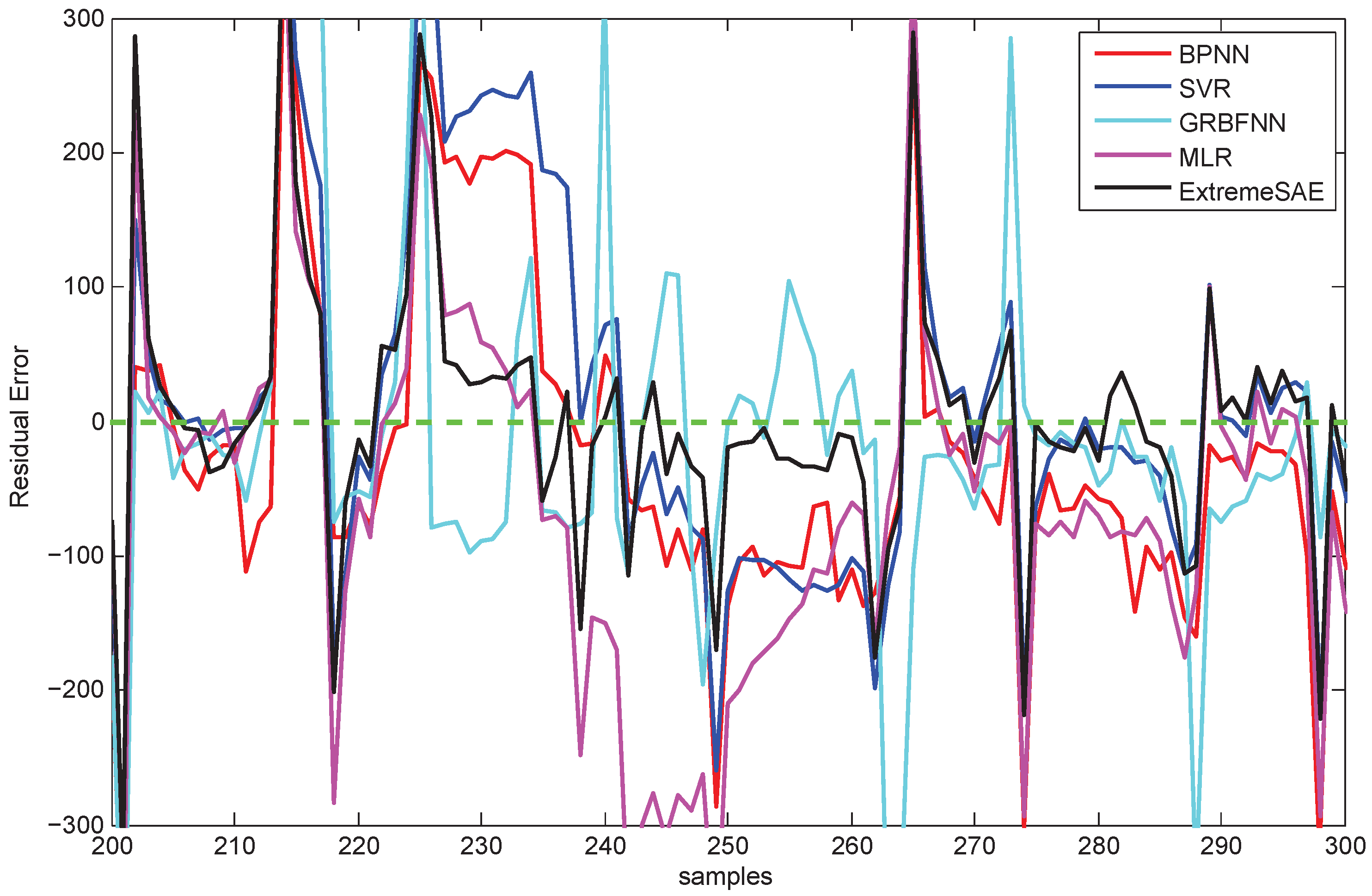
| 23.4814 | 23.5453 | 23.4509 | 23.1802 | |
| 22.9833 | 23.5639 | 23.3679 | 22.9015 | |
| 24.3893 | 24.2911 | 24.3733 | 24.6273 | |
| 23.9358 | 24.3908 | 24.5166 | 24.2795 | |
| 23.3932 | 24.2846 | 23.8729 | 24.0003 | |
| 24.0451 | 24.2820 | 24.4101 | 24.2295 | |
| 23.9541 | 23.8668 | 23.4668 | 23.9033 | |
| 23.3656 | 23.6728 | 23.5747 | 23.7575 |
| Performance | Training | Testing | |||||
|---|---|---|---|---|---|---|---|
| Methods | MAE | MRE (%) | RMSE | MAE | MRE (%) | RMSE | |
| Extreme SAE | 15.0231 | 3.0082 | 23.3090 | 13.3865 | 2.9174 | 22.9015 | |
| BPNN | 26.5890 | 4.9600 | 35.4052 | 21.3020 | 4.1792 | 30.8121 | |
| SVR | 15.8168 | 3.1991 | 25.3225 | 16.3592 | 3.6917 | 27.0380 | |
| GRBFNN | 11.7406 | 2.3532 | 17.7543 | 18.0785 | 3.8928 | 34.2312 | |
| MLR | 31.3272 | 6.4854 | 40.6747 | 25.7448 | 5.4652 | 38.8463 | |
| 59.4885 | 59.1812 | 59.8399 | 59.2147 | |
| 63.3515 | 63.4566 | 63.5216 | 63.1455 | |
| 62.3616 | 62.4175 | 62.9833 | 63.5690 | |
| 64.6232 | 64.9396 | 65.4826 | 68.3591 | |
| 63.9450 | 63.5129 | 64.6592 | 63.9566 | |
| 65.6216 | 64.4153 | 64.1315 | 64.5682 | |
| 66.2908 | 64.9708 | 66.1777 | 65.6557 | |
| 66.3097 | 64.3294 | 66.2774 | 66.3823 |
| Performance | Training | Testing | |||||
|---|---|---|---|---|---|---|---|
| Methods | MAE | MRE (%) | RMSE | MAE | MRE (%) | RMSE | |
| Extreme SAE | 32.1336 | 3.2429 | 54.3246 | 33.7168 | 3.6420 | 59.1812 | |
| BPNN | 65.0351 | 6.0898 | 85.4008 | 59.2456 | 6.3922 | 84.9968 | |
| SVR | 34.3843 | 3.5179 | 58.6403 | 43.4038 | 5.1010 | 77.3101 | |
| GRBFNN | 23.6996 | 2.3306 | 38.6174 | 38.6145 | 4.2105 | 80.7410 | |
| MLR | 63.9774 | 6.6008 | 85.2207 | 56.0647 | 5.9556 | 89.9583 | |
© 2017 by the authors. Licensee MDPI, Basel, Switzerland. This article is an open access article distributed under the terms and conditions of the Creative Commons Attribution (CC BY) license (http://creativecommons.org/licenses/by/4.0/).
Share and Cite
Li, C.; Ding, Z.; Zhao, D.; Yi, J.; Zhang, G. Building Energy Consumption Prediction: An Extreme Deep Learning Approach. Energies 2017, 10, 1525. https://doi.org/10.3390/en10101525
Li C, Ding Z, Zhao D, Yi J, Zhang G. Building Energy Consumption Prediction: An Extreme Deep Learning Approach. Energies. 2017; 10(10):1525. https://doi.org/10.3390/en10101525
Chicago/Turabian StyleLi, Chengdong, Zixiang Ding, Dongbin Zhao, Jianqiang Yi, and Guiqing Zhang. 2017. "Building Energy Consumption Prediction: An Extreme Deep Learning Approach" Energies 10, no. 10: 1525. https://doi.org/10.3390/en10101525
APA StyleLi, C., Ding, Z., Zhao, D., Yi, J., & Zhang, G. (2017). Building Energy Consumption Prediction: An Extreme Deep Learning Approach. Energies, 10(10), 1525. https://doi.org/10.3390/en10101525





